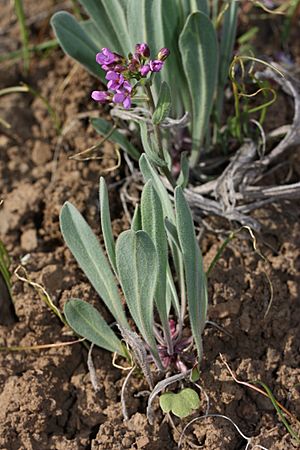Wallflower phoenicaulis facts for kids
Quick facts for kids Wallflower phoenicaulis |
|
|---|---|
 |
|
| Conservation status | |
| Scientific classification | |
| Genus: |
Phoenicaulis
|
| Species: |
cheiranthoides
|
Phoenicaulis is a special group of flowering plants. It is called a monotypic genus, which means it only has one type of plant in it. This single plant species is called Phoenicaulis cheiranthoides. You might know it by its common names: daggerpod or wallflower phoenicaulis.
What is Daggerpod?
Daggerpod is a type of plant known as a perennial herb. This means it lives for more than two years and usually has soft stems, not woody ones like trees. It grows one or more stems from a thick, short base called a caudex. These stems can reach about 25 to 30 centimeters (about 10 to 12 inches) tall.
Leaves and Flowers
The leaves at the bottom of the plant are long and narrow, shaped like a spear or a teardrop. They can grow up to 10 centimeters (about 4 inches) long. These lower leaves feel a bit fuzzy or woolly. Leaves higher up on the stem are shorter and usually have less hair.
The flowers grow in a cluster called a raceme. This means the flowers are on short stalks along a main stem. The flowers have pretty purple or pink petals. Each petal can be up to about 1.5 centimeters (about half an inch) long.
Fruits of the Daggerpod
After the flowers bloom, the plant produces a fruit. This fruit is a long, narrow pod called a silique. It is smooth and does not have hairs. The silique can grow up to 9 centimeters (about 3.5 inches) long. It holds the seeds for the next generation of daggerpod plants.
Where Does Daggerpod Grow?
Daggerpod is a tough plant that can grow in many different places. It especially likes rocky areas. You can find it in places like:
- Sagebrush scrub, which is a dry area with many sagebrush plants.
- Scree, which are slopes covered in loose, broken rocks.
- Exposed volcanic and clay slopes.
- Rock outcrops, hills, and banks.
- Meadows, which are open fields.
This plant can even grow high up in mountains, in what is called an alpine climate. This is a very cold and windy environment, similar to the climate above the tree line. Daggerpod can be found at elevations up to 3200 meters (about 10,500 feet) high.


